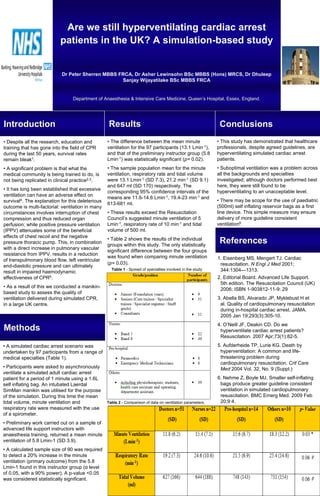Ventilation
- 1. Are we still hyperventilating cardiac arrest patients in the UK? A simulation-based study Dr Peter Sherren MBBS FRCA, Dr Asher Lewinsohn BSc MBBS (Hons) MRCS, Dr Dhuleep (Hons) Sanjay Wijayatilake BSc MBBS FRCA Department of Anaesthesia & Intensive Care Medicine, Queenâs Hospital, Essex, England. Queenâ Introduction Results Conclusions âĒ Despite all the research, education and âĒ The difference between the mean minute âĒ This study has demonstrated that healthcare training that has gone into the field of CPR ventilation for the 97 participants (13.1 Lmin-1), professionals, despite agreed guidelines, are during the last 50 years, survival rates and that of the preliminary instructor group (5.8 hyperventilating simulated cardiac arrest remain bleak1. Lmin-1) was statistically significant (p= 0.02). patients. âĒ A significant problem is that what the âĒ The sample population mean for the minute âĒ Suboptimal ventilation was a problem across medical community is being trained to do, is ventilation, respiratory rate and tidal volume all the backgrounds and specialties not being replicated in clinical practice2,3. were 13.1 Lmin-1 (SD 7.3), 21.2 min-1 (SD 9.1) investigated; although doctors performed best and 647 ml (SD 170) respectively. The here, they were still found to be âĒ It has long been established that excessive corresponding 95% confidence intervals of the hyperventilating to an unacceptable level. ventilation can have an adverse effect on means are 11.6-14.6 Lmin-1, 19.4-23 min-1 and survival4. The explanation for this deleterious âĒ There may be scope for the use of paediatric 613-681 ml. outcome is multi-factorial: ventilation in many (500ml) self inflating reservoir bags as a first circumstances involves interruption of chest âĒ These results exceed the Resuscitation line device. This simple measure may ensure compression and thus reduced organ Councilâs suggested minute ventilation of 5 delivery of more guideline consistent perfusion; while positive pressure ventilation Lmin-1, respiratory rate of 10 min-1 and tidal ventilation6. (IPPV) attenuates some of the beneficial volume of 500 ml. effects of chest recoil and the negative pressure thoracic pump. This, in combination âĒ Table 2 shows the results of the individual groups within this study. The only statistically References with a direct increase in pulmonary vascular significant difference between the four groups resistance from IPPV, results in a reduction was found when comparing minute ventilation 1. Eisenberg MS, Mengert TJ. Cardiac of transpulmonary blood flow, left ventricular (p= 0.03). resuscitation. N Engl J Med 2001; end-diastolic pressure and can ultimately Table 1 - Spread of specialties involved in the study 344:1304â1313. result in impaired haemodynamic effectiveness of CPR5. 2. Editorial Board. Advanced Life Support. 5th edition. The Resuscitation Council (UK) âĒ As a result of this we conducted a manikin- 2006; ISBN 1-903812-11-9: 29 based study to assess the quality of ventilation delivered during simulated CPR, 3. Abella BS, Alvarado JP, Myklebust H et in a large UK centre. al. Quality of cardiopulmonary resuscitation during in-hospital cardiac arrest. JAMA. 2005 Jan 19;293(3):305-10. 4. OâNeill JF, Deakin CD. Do we Methods hyperventilate cardiac arrest patients? Resuscitation. 2007 Apr;73(1):82-5. âĒ A simulated cardiac arrest scenario was 5. Aufderheide TP, Lurie KG. Death by undertaken by 97 participants from a range of hyperventilation: A common and life- medical specialties (Table 1). threatening problem during cardiopulmonary resuscitation. Crit Care âĒ Participants were asked to asynchronously Med 2004 Vol. 32, No. 9 (Suppl.) ventilate a simulated adult cardiac arrest patient for a period of 1 minute using a 1.6L 6. Nehme Z, Boyle MJ. Smaller self-inflating self inflating bag. An intubated Laerdal bags produce greater guideline consistent SimMan manikin was utilised for the purpose ventilation in simulated cardiopulmonary of the simulation. During this time the mean resuscitation. BMC Emerg Med. 2009 Feb tidal volume, minute ventilation and Table 2 - Comparison of data on ventilation parameters. 20;9:4. respiratory rate were measured with the use of a spirometer. âĒ Preliminary work carried out on a sample of advanced life support instructors with anaesthesia training, returned a mean minute ventilation of 5.8 Lmin-1 (SD 3.9). âĒ A calculated sample size of 90 was required to detect a 20% increase in the minute ventilation (primary outcome) from the 5.8 Lmin-1 found in this instructor group ( level of 0.05, with a 90% power). A p-value <0.05 was considered statistically significant.
